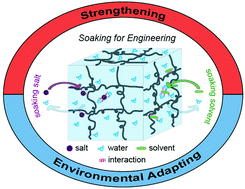Engineering hydrogels by soaking: from mechanical strengthening to environmental adaptation
Abstract
Recently, numerous research studies have contributed to engineering hydrogels by soaking strategies to obtain designed properties, from mechanical strengthening to environmentally adapting. Hydrogels are three-dimensional hydrophilic polymer networks dispersed in water with widespread applications. However, most of the traditional hydrogels possess limited mechanical strength and poor temperature and environmental tolerance, which limits their applications. Due to their unique water-rich property, the physical and chemical properties of hydrogels can be post-engineered by facile soaking strategies. The soaking strategies can be divided into two categories: the first involves soaking salt solutions into the aqueous phase of the gel, and the second involves soaking in organic solvents to displace the water in the gel, forming organohydrogels. In this feature article, we aim to summarize the most recent progress in designing and engineering hydrogels using soaking strategies, including strengthening hydrogels with superior mechanical properties, and providing the hydrogels with environmentally adapting properties, such as anti-freezing and anti-dehydration. The first section summarizes some common design principles and fabrication methods to strengthen hydrogels by soaking, and then it introduces some successful applications of these soaking-induced tough hydrogels. In the second section, the soaking strategy to engineer hydrogels with environmentally adapting properties is discussed. In the end, a brief outlook is proposed based on current challenges and the pros and cons of the soaking strategy.



 Please wait while we load your content...
Please wait while we load your content...